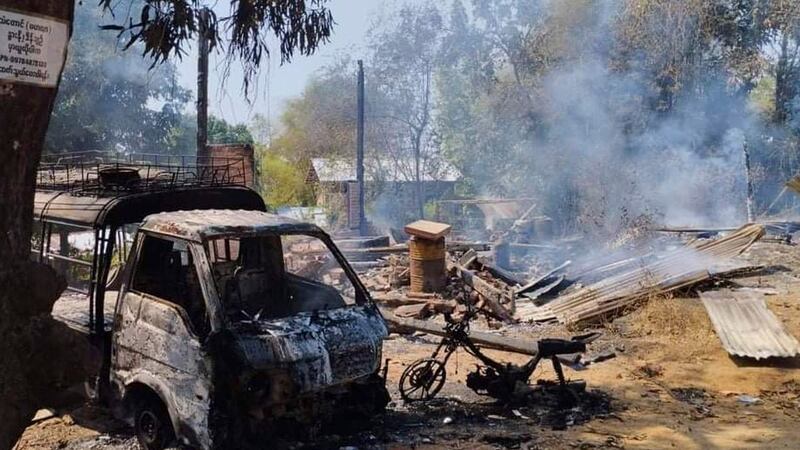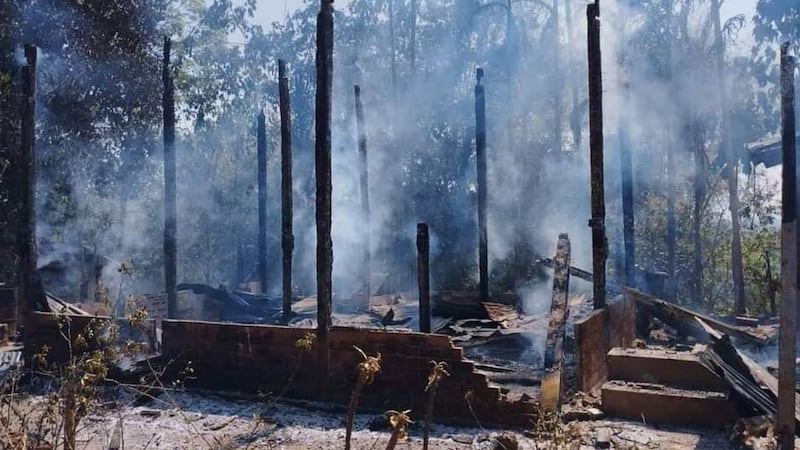No one has returned to the once-picturesque hilltop resort town of Thanduang in southern Myanmar.
Six weeks after junta troops shelled the town in Kayin state, the more than 8,000 residents who fled are too scared to return to their homes for fear of further attacks by the military, they have told Radio Free Asia. Junta forces are still firing shells into the town.
The ghost town is just one of scores across the country where people have fled fighting that has engulfed the country since the military coup d’etat two years ago.
It has plunged the country into a humanitarian disaster. In Kayin state alone, more than 100,000 people have been forced to flee their homes, part of the 1.35 million people across the country who have been displaced, according to U.N. figures.
An aid worker said that many of the refugees are staying within an hour’s distance to Thandaung and monitoring the situation while receiving assistance from civil society groups.
They are sheltering in nearby Pyar Sa Khan village, Bago region’s Taungoo city – approximately 21 kilometers (13 miles) to the southwest – and several other villages in the vicinity, said the worker, who spoke on condition of anonymity, citing fear of reprisal. “Others are taking refuge in the homes of friends and relatives in Taungoo.”
Trigger
Fighting broke out on Jan. 27 after snipers from an unidentified armed group fired on a military base camp located on a nearby hill, killing at least one soldier, and has continued since, said a resident of Thandaung who fled the area and declined to be named for security reasons.
The area has typically been under the control of the Karen National Liberation Army, although it was unclear whether the group was responsible for the attack on the military camp.
“In fact, there was no major fighting here before, but someone in the military was shot and killed by an unidentified person or group,” the resident said. “After that, the military continuously fired [shells] into civilian neighborhoods in the city for three days. The residents were too scared to stay and fled their homes.”
In one attack on Jan. 28, the military fired two 40 millimeter shells into the city, despite there being no fighting at the time, causing damage to the Shin Mar Ku Temple in ward No. 2.

The shelling has shattered the peace in the once tranquil town of more than 18,000 mostly ethnic Karen people, which was developed as a hill station during the British colonial era of 1885-1948.
The resident said it is still not safe enough to return home, although he has since visited the area briefly to feed his livestock.
A resident of Thandaung using the pseudonym Saw Khwar Doe who had been arrested by junta forces on Dec. 16 while traveling to an area rubber plantation told RFA that although he had since been released, the tenuous situation in the city had forced him to leave his home and farm and move to Taungoo.
“I pray that the military junta falls – only then will we be able to mind our work in our own homes with our families together peacefully,” he said.
Other residents of the area said that although the township administration, military forces and religious organizations are in discussions to facilitate a return of the displaced, it is still impossible to begin the process because of the junta’s frequent firing of artillery and burning of civilian homes.
“Our local organizations met and held discussions with the commander of the military troops to allow the safe return of the refugees. We requested that he help us,” another resident of Thandaung said.
“We hope to return if there is no more fighting. But since there have been more attacks, the residents have lost faith in the negotiations and still can’t go back to their homes.”
Houses burned
Since the initial fighting, the military has burned down the homes of Thandaung Karen National Union Chairman Tun Ke and a KNLA schoolteacher in January, and eight homes in ward No. 1 on Feb. 21. On March 4, the military also torched six houses in ward No. 2 and three others in ward No. 3 – most of which belonged to local schoolteachers and Christian religious leaders, residents said.

But a source with close ties to the junta’s Thandaung city administrator told RFA that the houses caught fire after members of an unidentified armed group fired on the military, prompting clashes.
“Those [unidentified people] fired with sniper rifles and other guns, so the military responded and they exchanged fire,” he said.
“There are some residents who remain in the city … and want to live peacefully. That’s why they report to the military, frankly speaking. When they reported the shooters’ whereabouts, the military started chasing after them and they exchanged fire. That’s how the houses caught fire.”
A week prior to the exchange on Jan. 27, more than 10,000 civilians fled their homes in Kayin state’s Kyondoe city and nearby villages amid intensified fighting between junta troops and combined Karen National Liberation Army forces.
Translated by Myo Min Aung. Edited by Joshua Lipes and Malcolm Foster.
